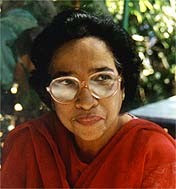A
walk through the Kathe Kollwitz Museum on the Neumarkt Passage in Cologne is a
journey through the life of a woman, who used her art and talent to show her
deep concern for the less fortunate. Her’s was a lifelong fight against social
injustice. The large imposing self-portrait that greets one at the entrance is
of an unsmiling woman, strong and determined to leave ‘footprints on the sands
of Time.’ The museum is bright and airy. Spread over 1000 feet, it is the
largest collection of her work, from charcoal drawings to etchings, lithography
and sculptures in bronze.
Kathe
Kollwitz (nee Schmidt) was born in Konigsberg, Russia on the 8th of
July, 1867. Her father Karl Schmidt a
social democrat, brought up his children to be sensitive to the plight of the
poor and working class. Her maternal grandfather Julian Rupp a Lutheran priest,
also exerted a positive influence on her vis-s-vis
Religion and Socialism.
Kathe
was given to fits of depression from an early age.She also frequently suffered
from migraine and hallucinations. However, this did not detract from her
artistic talents. At the age of 12, her father arranged for her to take lessons
from a local copper engraver. She also made plaster casts and copied the work
of famous artists. By the age of 16, she was already drawing pictures of
peasants and working class people.
As
women were not enrolled in colleges in Russia, Kathe attended a Women’s Arts
College in Berlin. She was greatly influenced by the work of Max Klinger and
paid special attention not only to his techniques but also to his social
concerns. In Berlin, she developed a deep friendship with fellow artist Emma
Jeep. Their friendship lasted for many years. As it was difficult to find
models, Emma posed for her in the nude in the privacy of their rooms.
Later,they both transferred to an Arts College in Munich where they completed
their education.
Emma
was unhappy with Kathe’s decision to get married. She felt marriage would stand
in the way of Kathe’s progress in Arts. But Kathe was not one to be easily
influenced. She married Dr. Karl Kollwitz a member of the SDP, who worked in
the poorer section of Berlin. In his clinic she learnt more about the lives of
ordinary people, especially women who came there with multiple complaints. At
first, she was only attracted to proletarian life. But later, she was touched
with compassion by their sad stories. It was here that she learnt to “extract
the emotional content from every situation and reproduce it.”
Kathe’s
cycle of work on “The Weavers” was inspired by a play by Gerhart Hauptmann
describing the oppression of Siberian weavers in 1842, and their failed revolt
against industrialization. In five years, she produced six works depicting
poverty, death, conspiracy and street marches. These canvases brought her wide
acclaim.
Her
second cycle of work was on the Peasants’ War of 1525. This too was inspired by
another play of Gerhardt Hauptmann. Her series of pictures described the
violence and carnage that followed after the peasants’ revolt against feudal
lords and church leaders.
From
1901 to 1904 Kathe studied sculpture in Paris. In 1907 she spent a year in
Florence as part of the Villa Roman Prize she won. Here she was exposed to
Medieval and Renaissance Art. Kathe decided early in her career that she had no
feeling for colour and its subtle uses. In 1909, ahe began to experiment with
sculpture.
Kathe
went into deep depression after the death of her son Peter, in World War I
1914. Out of this grief was born the sculpture of her famous work “Grieving
Parents,” which stands today in the Vladso German cemetery, as a memorial to
her son.
In
1919, Kathe was the first woman to be elected to the Prussian Academy of Arts.
It ensured a regular income, a studio and full Professorship at the Academy.
But in spite of all her fame and achievements she was unimpressed by worldly
possessions and lived in the poor quarter of Berlin.
Kathe’s
self portraits are 84 in all. Some said they were ‘psychological milestones’
depicting her quest for self appraisal. Sadly there is not even a smile in any
one of them. It makes her look stern, unfeeling and humourless. But she was
extremely kind and unassuming. According to her interviewer Agnes Smedley,
Kathe’s rule of life was ‘Love.’
Being
a socialist and a pacifist, she spoke against war. “There has been enough
dying. Let there not be another war,” she said. She was an active member of the
Women’s International League for Peace and Freedom. But her anti-war posters
and pamphlets against war, hunger, deprivation did not go well with those in
power. In 1933, she was forced to resign her place in the Academy of Arts, and
stripped of all privileges. Her work was removed from all the museums and art
galleries. She was banned from exhibiting her work. Yet her pictures of ‘Mother
and Child’ were used for Nazi propaganda without her permission.
Kathe
now began to work from her own small studio. From 1930 onwards it seems that
she was preoccupied with the subject of Death. Her eight pictures in this section
are deeply disturbing and reflect the state of chronic
grief in her mind.
In
July 1936, both she and her husband were threatened by the Gestapo, who wanted
to send them to a concentration camp. The couple decided to commit suicide
rather than imprisonment. But the order had to be rescinded because of public
outcry. Kathe was too famous to be ill treated.
After
the death of her husband in1940, Kathe went through another episode of
depression. In1943, her house was bombed and many of her drawings, prints and
documents were destroyed. She moved to Nordhausen and then to Moritzburg near
Dresden, where she spent her last days as the guest of Prince Ernst Heinrich of
Saxony. She died on 22nd April 1945 at the age of 78. Her tomb lies
in Freidrichsfelde in Berlin.












